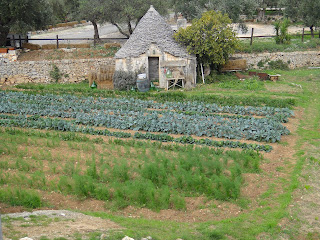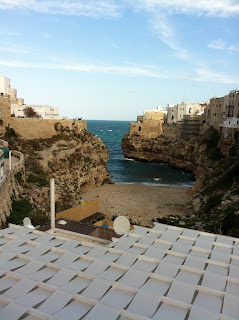Arrival in Taormina
Our flight into Sicily was supposed to be into Catania. But, Catania is closed for repairs so we flew into a US Navy air strip and were bused to Catania. The problem seemed to be busing the luggage too. This was the first day that Catania closed so they had not yet gotten their process worked out. We waited maybe 2 hours for our luggage to appear. This was a mixed blessing. People on our tour began to speak to each other, We could recognize each other by the white Odyssey tags on our carry-on bags. This wait in the relatively chair-less drab airport terminal was a kind of trial-by-fire and began the bonding of the group.
After we each, one at a time, got our luggage through scanning and customs, we walked out through sliding glass doors that opened as we approached. I was one of the last ones out. And after such a long flight, and such a long wait, and such little sleep, the walking through the doors felt like a 'coming into the light' to a large group of people cheering each time the doors opened. Gaetano was there in the group with a big smile welcoming each one, waving an Odyssey sign. When everyone was out, he counted us all (in Italian) and we all walked through a shopping mall to a bus to drive to Taormina. It felt so good to be taken care of.
The Bella Angela Hotel is almost at the top of the mountain that Taormina hugs. Each room has a balcony looking out on the magnificent Mt Etna. One of my favorite parts of the tour is being able to sit on our own balcony each morning and look at Mt Etna; different each day. Cloud formations all seemed to relate to the bulk of Mt Etna in some way. One day was cloudy and a bit rainy and you could hardly see the mountain. Another, the whole mountain could be seen clearly.
h
Taormina
Our local guide, Mellina, led us along the Main Street in Taormina through the ancient arches of the old walled city and through the city squares.
Naxos, the town we could see across the Bay of Naxos, was the first town founded by the ancient Greeks in Sicily. The Greeks settled Sicily 2500 years ago much as the Europeans settled the Americas more then a millenium later. Taormina was founded by survivors of Naxos after it was invaded by Carthage.
The Greeks built temples, as they did everywhere they settled, and theaters which were first used as adjuncts to the temple worship. Taormina has a large theater overlooking the coast. Greek theaters were minimal structures and used the scenic beauty of the location as the background for the events held there. This theater was later rebuilt by the Romans who had a very different idea of the use and form of such spaces.
They created an amphitheater with columns and marble backdrop hiding the gorgeous scenery. Here they held typical Roman circus events with wild animals and gladiators. Lucky for us, most of Roman-built superstructure has not survived and we can see the coastline much as the early Greeks must have enjoyed it.
 |
| Bill, Joyce, Don, Jewel, Danny, Anita |
He serenaded us with Sicilian love songs, flirted with Jewel, and was generally a very memorable character.
Agrigento - The Valley of the Temples
 |
| Gaetano and Bonita in front of the Temple of Concordia |
Rainy day today at the start - can't see Mt Etna at all - but it began to clear up by the end of breakfast, and by the afternoon it was beautiful, chilly and windy. A 3 hour bus ride to Agrigento was well used by Gaetano talking about the agriculture, history, mythology, history (lots of history), politics, literature, etc of Sicily. He is a font of knowledge and a great story teller. Think of the best history teacher you ever had - and then some. What do you expect from a PhD in Comparative Literature?
More Pictures of Taormina:
 |
| found a sweet little dress for Lily |
 |
| Sebastian serenading Jewel |
 |
| Joyce and Bill had the balcony right next to ours |
 |
| Joyce got serenaded too |

.JPG)



































































